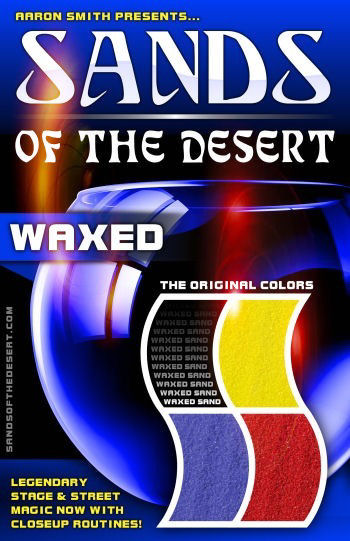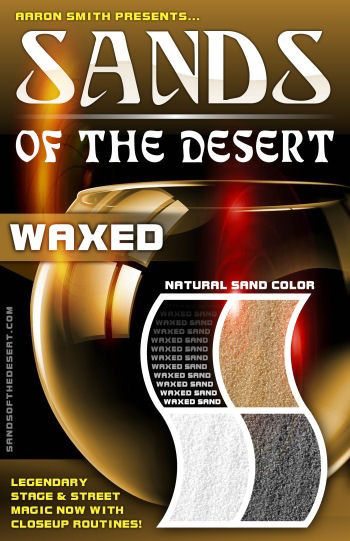The Official Sands of the Desert Buyer’s Guide!
By Aaron Smith
I am a little biased when it comes to Sands of the Desert. In my opinion, it is one of the greatest magic tricks ever invented. It isn’t my trick—it isn’t anyone’s trick—it belongs to the community as a whole. It may have been invented by magicians in India hundreds of years ago, or by the Italian magician Giovanni Giuseppe Pinetti in the late 1700’s, or it might be the result of a misunderstanding—a different trick described incorrectly by one magician to another. More on that in a future article.
However it came about, Sands of the Desert is here to stay. Over the years, very little has changed. The methods behind the trick have, relatively speaking, stayed the same. Even the performance of the trick is fairly standard. It’s a simple trick. But of course, the best tricks always are. Audience reactions to Sands of the Desert are remarkable. Magic that bridges the language barrier. Perfect for all ages. Packs flat and plays big. The trifecta!
And on top of all that, there is something about this trick I just can’t seem to let go. I devote a considerable amount of my time to investigating both its history and its future. Over the past three years, I have released several Sands of the Desert products, and over the next year, I plan to release several more. This trick will soon be unrecognizable in its current form (it already is if you have my recent instructions where I published a couple of my most prized never-before-seen-in-print Sands tricks).
If you want to come along on this journey, to watch the mystery unravel and to witness what this incredible trick can do for your stage, street, or closeup show, then it all starts with a choice: which Sands of the Desert sand is right for you?
Lucky for you, you don’t have to go through this alone. I have prepared this easy to follow Buyer’s Guide.
Before we begin, I should clarify one point. There are other ways to perform Sands of the Desert besides specially treated sand. Two are quite popular: the hollow ball method and a gimmicked vessel. Both of these have their advantages, but their versatility overall is quite limited. Neither will work for all (or even most) of the tricks outlined in the instructions that come with my Sands of the Desert and they will not work with the tricks I have slated for release in the future.
Otherwise, there are two types of Sands of the Desert sand. Both are hydrophobic—literally, afraid of the water. You can buy cheap hydrophobic sand in a number of places on the Internet, or even make your own. But the sand available here—the sand being discussed in this article—is a specific brand of sand. It is performer-grade hydrophobic sand. Made specifically for magicians from years of research. The sand you buy from me is handcrafted in small batches by yours truly. If you buy Sands of the Desert from another store, make sure it has the labels you see on these pages. I guarantee its quality.
1. Wax Sand
 Waxed sand is the oldest version of magic sand. Methods for making waxed hydrophobic sand were first exposed in the 1800’s by the likes of Roderburg, Hercat, Kellar, and Dr. Holden. However, the science behind the magic has been well-known since the ninth century, when the Persian chemist Razi wrote about the special oils in his “Book of Secrets,” the Kitab al-Asrar.
Waxed sand is the oldest version of magic sand. Methods for making waxed hydrophobic sand were first exposed in the 1800’s by the likes of Roderburg, Hercat, Kellar, and Dr. Holden. However, the science behind the magic has been well-known since the ninth century, when the Persian chemist Razi wrote about the special oils in his “Book of Secrets,” the Kitab al-Asrar.
For years, magicians have made their own Sands of the Desert magic sand with store-bought wax, typically white paraffin wax. What many magicians don’t realize is that the sand works despite the paraffin. When regular folks say, “wax,” they picture a block of wax, not a fatty acid. In fact, the impurities within a regular block of wax must be burned off—removed completely—before the waxed sand will work for Sands of the Desert. In my process, I simply eliminate the impurities all together and use a plant-based product instead.
Wax Sand Pros:
Waxed sand stays together well underwater when squeezed into a clump and can withstand vigorous stirring. The magician can easily perform with more than three colors of sand, which significantly increases the magic aspect when the colors separate for the grand finale. Instead of just cheap paraffin wax, the way traditional wax sand is made, the new process creates a more durable sand (lasts longer no matter how many times it clumps together), and falls apart easily for the big reveal when it is removed from the water. Waxed sand can stay underwater longer than synthetics, without succumbing to the pressure of the water.
Wax Sand Cons:
I tried to eliminate as many cons as possible, but some aspects of wax sand are a fundamental characteristic of this type of product. Wax sand “clumps” together when you squeeze it in your hand. Some magicians view this as a feature, while others prefer the clump-free nature of synthetic sands. During the wax sand manufacturing process, sometimes more than one grain will stick together—waxed sand granuals are bigger than their synthetic counterpart, not as uniform, and may float on top of the water. Heat can damage waxed sand. To use Waxed Sand, the magician pours the Sand into their hand, squeezes, and places the clump into the water on the bottom of the vessel. Traditionally, Waxed Sands are not poured into the water.
Click here to see Sands of the Desert WAX!
2. Synthetic Sand
 The first synthetic hydrophobic sand was patented by Wham-O in 1980. Their method is still the standard: silica-based sand exposed to the vapors of trimethylsilanol. The chemicals are relatively cheap when purchased in bulk, but making it is time consuming. A small operation can only produce a few pounds of performer-grade sand in a day.
The first synthetic hydrophobic sand was patented by Wham-O in 1980. Their method is still the standard: silica-based sand exposed to the vapors of trimethylsilanol. The chemicals are relatively cheap when purchased in bulk, but making it is time consuming. A small operation can only produce a few pounds of performer-grade sand in a day.
Some magicians have tried making their own sand using spray waterproofer. Such methods are not even in the same league as the method described above. Synthetic hydrophobic sand would have been lost to magicians when Wham-O discontinued their sand, had it not been for Gerald Kirchner, owner of Magic City. Through considerable effort and a great deal of investment, he was able to find a company to make high-grade synthetic hydrophobic sand in the 1990’s. Since then, he has increased the quality and consistently produces some of the best synthetic sand on the market.
Synthetic Sand Pros:
The coating on synthetic sand is thin, barely a molecule thick in most instances. Treated sand looks identical to regular sand. The grains are uniform and flow easily, just like regular sand. The sand retains its density after treatment, so it sinks to the bottom of the vessel easier than waxed sand. Synthetic sand can be poured from a greater distance from the water’s surface, and will “curl up” on the bottom with little effort from the magician. Heat has little effect on synthetic sand.
Synthetic Sand Cons:
The thinner coating wears off and can dry out if left in the open air (though it will repair itself if left in an enclosed container). Almost all colored sands available—even outside the magic industry—are a regular white sand painted to the desired color. The paint can liquify during the vapor process, creating an improper seal on the grain. Synthetic sands do not clump—at all—so you cannot stir the water as vigorously as a waxed sand. Some tricks are much harder to perform with synthetic sand than the new wax sand.
Click here to see Sands of the Desert SYNTHETIC!
The type of Sands of the Desert sand you choose is ultimately a personal decision you will have to make. Neither will go to waste. Consider buying both to see which you like better.
Waxed sand and synthetic sand are very different substances, both in look and feel. If you have tried one, but not the other, now is your chance to get a good quality product and add this legendary effect to your repertoire.
Like I say in the instructions:
“Sands of the Desert has been handed down from generation to generation; from magician to magician. Now it is handed to you. Take it and make it your own. Perhaps someday, you will be part of this incredible trick’s amazing history.”
Are You a Magic Store Looking for Wholesale?
The Sands of the Desert products we sell on this website are the best on the market; engineered for magicians through years of testing and research. We are dedicated to our product line and will continue to innovate this incredible trick, ensuring Sands of the Desert will live on for generations of magicians to come.
If you are a magic shop, you can buy our products from your favorite distributor or direct from our wholesale site, GadflyMagic. On the website, www.gadflymagic.com, there is a list of authorized distributors. Once you stock our merchandise from an official source, send us an email and we will add you to the list of authorized retailers.
Our other brands include Poor Boy Magic, Magic by Stat, ManipQuick, MagiciansWax (includes WaxTaqs), and Puppet Master PK.
Sands of the Desert Mission Statement
We believe Sands of the Desert is one of the greatest magic tricks ever created for stage or closeup. It is important to preserve its history and to ensure its future. If you have read the instructions packaged with our Sands, then you are aware of our attention to detail.
Over the years, Sands of the Desert sand has been made in a variety of ways, but never before has there been such focus on the quality. At sandsofthedesert.com, our goal is to consistently produce the highest quality magic sand on the planet. The sand you buy from us is made in the United States from the finest materials. Every batch is checked by a magician for optimal performance.
You are invited to be a part of the process. If you have notes or tweaks for our sand or any of the products you buy on our website, please, contact us by email or use the comments below to provide your feedback. The goal is an epic show. The best magic in the world, flowing from your hands and into the minds of your audience.
